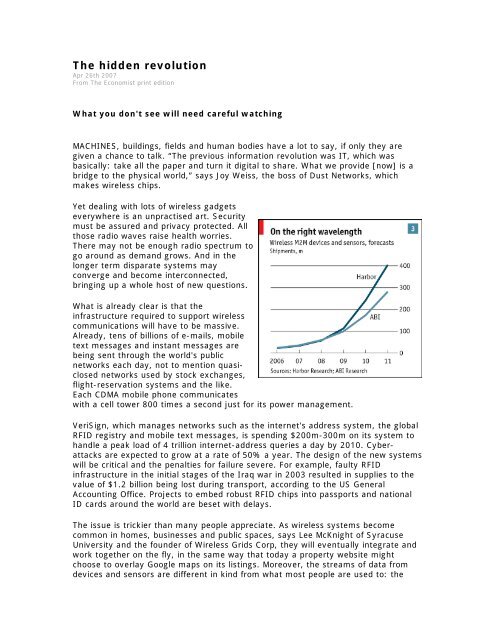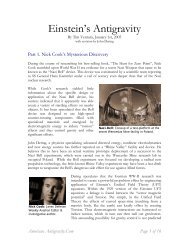A world of connections - Signal Lake Venture Fund
A world of connections - Signal Lake Venture Fund
A world of connections - Signal Lake Venture Fund
You also want an ePaper? Increase the reach of your titles
YUMPU automatically turns print PDFs into web optimized ePapers that Google loves.
The hidden revolution<br />
Apr 26th 2007<br />
From The Economist print edition<br />
What you don't see will need careful watching<br />
MACHINES, buildings, fields and human bodies have a lot to say, if only they are<br />
given a chance to talk. “The previous information revolution was IT, which was<br />
basically: take all the paper and turn it digital to share. What we provide [now] is a<br />
bridge to the physical <strong>world</strong>,” says Joy Weiss, the boss <strong>of</strong> Dust Networks, which<br />
makes wireless chips.<br />
Yet dealing with lots <strong>of</strong> wireless gadgets<br />
everywhere is an unpractised art. Security<br />
must be assured and privacy protected. All<br />
those radio waves raise health worries.<br />
There may not be enough radio spectrum to<br />
go around as demand grows. And in the<br />
longer term disparate systems may<br />
converge and become interconnected,<br />
bringing up a whole host <strong>of</strong> new questions.<br />
What is already clear is that the<br />
infrastructure required to support wireless<br />
communications will have to be massive.<br />
Already, tens <strong>of</strong> billions <strong>of</strong> e-mails, mobile<br />
text messages and instant messages are<br />
being sent through the <strong>world</strong>'s public<br />
networks each day, not to mention quasiclosed<br />
networks used by stock exchanges,<br />
flight-reservation systems and the like.<br />
Each CDMA mobile phone communicates<br />
with a cell tower 800 times a second just for its power management.<br />
VeriSign, which manages networks such as the internet's address system, the global<br />
RFID registry and mobile text messages, is spending $200m-300m on its system to<br />
handle a peak load <strong>of</strong> 4 trillion internet-address queries a day by 2010. Cyberattacks<br />
are expected to grow at a rate <strong>of</strong> 50% a year. The design <strong>of</strong> the new systems<br />
will be critical and the penalties for failure severe. For example, faulty RFID<br />
infrastructure in the initial stages <strong>of</strong> the Iraq war in 2003 resulted in supplies to the<br />
value <strong>of</strong> $1.2 billion being lost during transport, according to the US General<br />
Accounting Office. Projects to embed robust RFID chips into passports and national<br />
ID cards around the <strong>world</strong> are beset with delays.<br />
The issue is trickier than many people appreciate. As wireless systems become<br />
common in homes, businesses and public spaces, says Lee McKnight <strong>of</strong> Syracuse<br />
University and the founder <strong>of</strong> Wireless Grids Corp, they will eventually integrate and<br />
work together on the fly, in the same way that today a property website might<br />
choose to overlay Google maps on its listings. Moreover, the streams <strong>of</strong> data from<br />
devices and sensors are different in kind from what most people are used to: the





